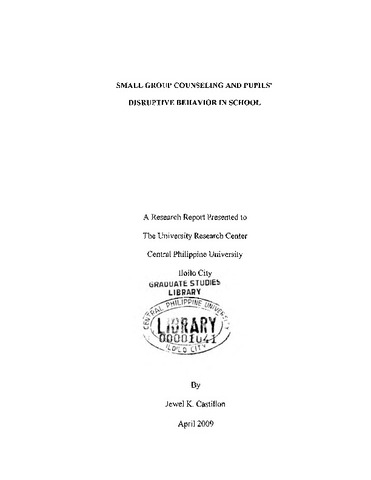Small group counseling and pupils’ disruptive behavior in school
| dc.contributor.author | Castillon, Jewel K. | |
| dc.date.accessioned | 2021-05-31T06:47:35Z | |
| dc.date.available | 2021-05-31T06:47:35Z | |
| dc.date.issued | 2009-04 | |
| dc.identifier.citation | Castillon, J. K. (2009). Small group counseling and pupils’ disruptive behavior in school (Research report). Jaro, Iloilo City: University Research Center, Central Philippine University. | en_US |
| dc.identifier.uri | https://hdl.handle.net/20.500.12852/933 | |
| dc.description | Abstract only Full text available | en_US |
| dc.description.abstract | The purpose of the study is to assess the effectiveness of Small Group Counseling as intervention to disruptive pupils referred to the guidance office for counseling. To achieve this, the pretest and posttest of the experimental and control group was obtained and compared. The subjects of the study were the twenty referred pupils for counseling from Grade IV, V, and VI of Central Philippine University Elementary School for the School Year 2008 - 2009. The twenty referred pupils were randomly assigned into two groups: the experimental group and the control group. Ten pupils composed each group. Pupils assigned in the experimental group were further divided into small groups composed of three to four members. These small groups met regularly for six sessions, which served as the intervention of the study. The instrument used to measure pupils’ disruptive behavior is the Vanderbilt ADHD Rating Scale - Teacher form, a standardized instrument that has been used in several studies to measure children’s disruptive. Six teachers rated each of the subjects of the study for their pretest and posttest of both the experimental and control group. The frequency count, mean, and standard deviation were used as descriptive statistics. The t-test was used to determine whether there is significant difference between the experimental group and control group's pretest and posttest ratings. All statistical computations were processed using the Statistical Package for Social Science (SPSS) software with the level of significance set at .05 alpha. Using the t-test, result showed that there is a significant difference in the pretest scores of the experimental and control group in both Inattention and Hyperactive/Impulsive dimensions. This means that pupils in the experimental group are significantly disruptive compared to those in the control group. There is no significant difference in the pretest and posttest mean scores of the experimental group as a whole in both Inattention and Hyperactive/Impulsive dimensions, which imply that there is no significant change in pupils’ behavior before and after they have participated in small group counseling. There is no significant difference in the pretest and posttest mean scores of the control group as a whole in both Inattention and Hyperactive/Impulsive dimensions. This means that their pretest and posttest behavior remained the same before and after intervention was given to children in the experimental group. | en_US |
| dc.format.extent | ix, 52 leaves | en_US |
| dc.language.iso | en | en_US |
| dc.publisher | Central Philippine University | en_US |
| dc.subject.ddc | GSL 371.4072 C278 | en_US |
| dc.subject.lcsh | School children | en_US |
| dc.subject.lcsh | Central Philippine University--Students | en_US |
| dc.subject.lcsh | Behavior disorders in children | en_US |
| dc.subject.lcsh | Small groups | en_US |
| dc.subject.lcsh | Counseling | en_US |
| dc.subject.lcsh | Educational counseling | en_US |
| dc.subject.lcsh | Counseling in elementary education | en_US |
| dc.subject.lcsh | Group counseling | en_US |
| dc.subject.lcsh | Group counseling for children | en_US |
| dc.title | Small group counseling and pupils’ disruptive behavior in school | en_US |
| dc.type | Technical Report | en_US |
| dcterms.accessRights | Limited public access | en_US |
| dc.description.bibliographicalreferences | Includes bibliographical references | en_US |
| local.subject | Central Philippine University (CPU). Elementary School. | en_US |
Fichier(s) constituant ce document
Ce document figure dans la(les) collection(s) suivante(s)
-
Research reports [167]
-
Research reports [10]





